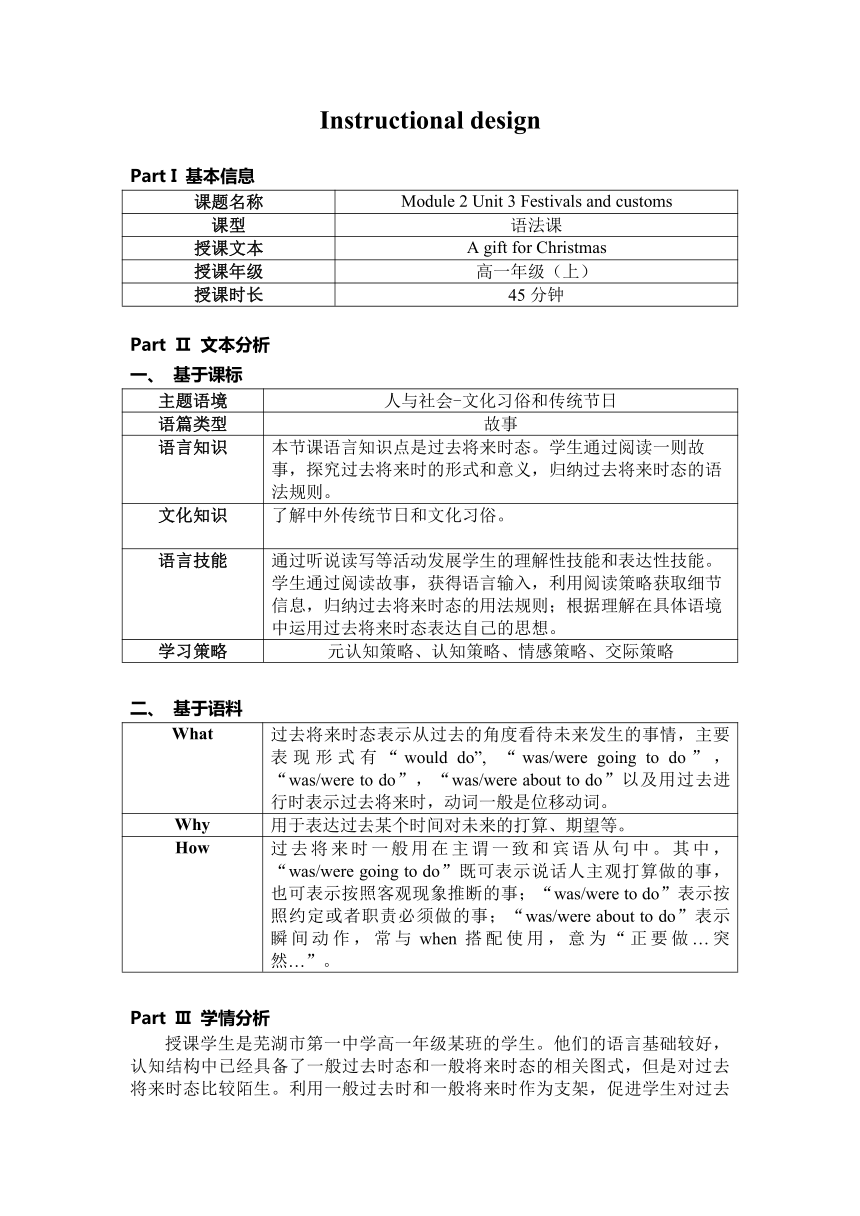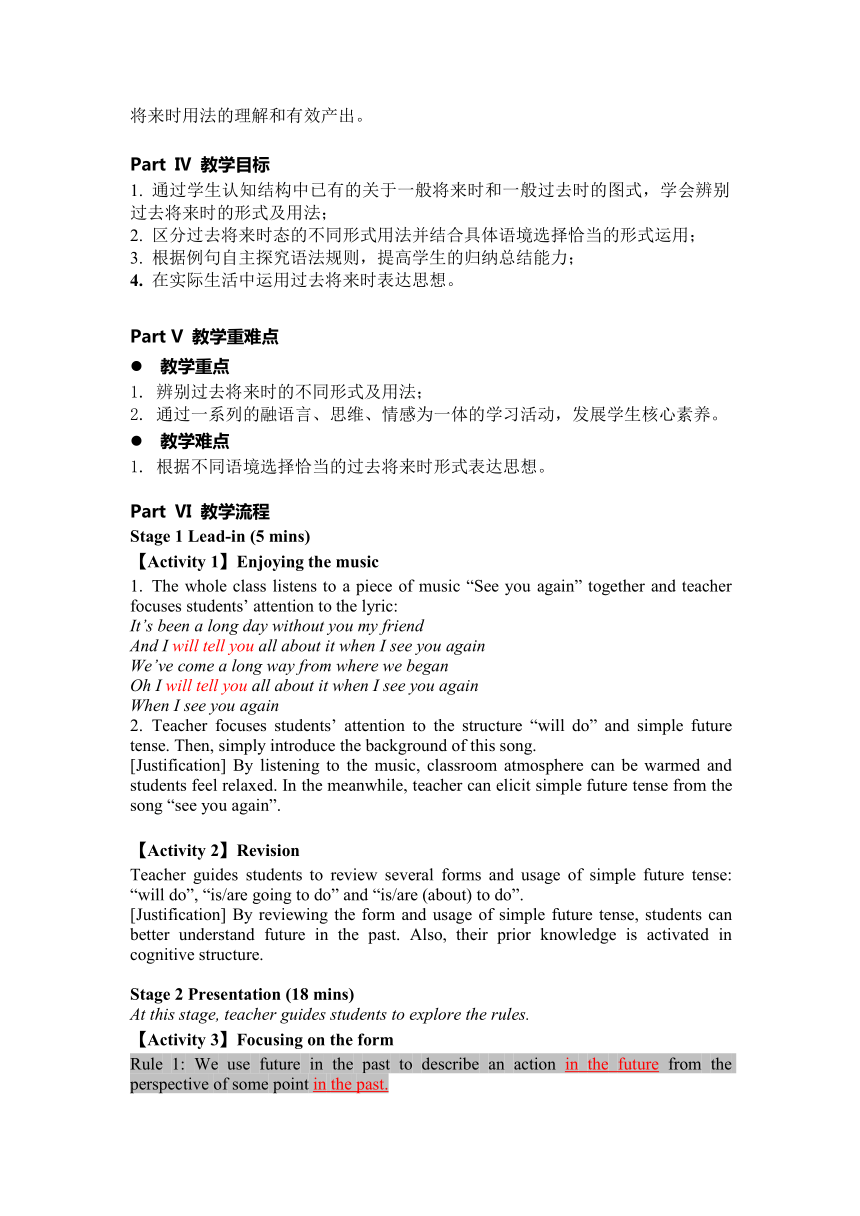牛津译林版(2019)必修 第二册Unit 3 Festivals and customs Grammar and usage教学设计
文档属性
| 名称 | 牛津译林版(2019)必修 第二册Unit 3 Festivals and customs Grammar and usage教学设计 |

|
|
| 格式 | docx | ||
| 文件大小 | 37.5KB | ||
| 资源类型 | 教案 | ||
| 版本资源 | 牛津译林版(2019) | ||
| 科目 | 英语 | ||
| 更新时间 | 2024-03-14 20:32:08 | ||
图片预览


文档简介
Instructional design
Part I 基本信息
课题名称 Module 2 Unit 3 Festivals and customs
课型 语法课
授课文本 A gift for Christmas
授课年级 高一年级(上)
授课时长 45分钟
Part Ⅱ 文本分析
基于课标
主题语境 人与社会-文化习俗和传统节日
语篇类型 故事
语言知识 本节课语言知识点是过去将来时态。学生通过阅读一则故事,探究过去将来时的形式和意义,归纳过去将来时态的语法规则。
文化知识 了解中外传统节日和文化习俗。
语言技能 通过听说读写等活动发展学生的理解性技能和表达性技能。学生通过阅读故事,获得语言输入,利用阅读策略获取细节信息,归纳过去将来时态的用法规则;根据理解在具体语境中运用过去将来时态表达自己的思想。
学习策略 元认知策略、认知策略、情感策略、交际策略
基于语料
What 过去将来时态表示从过去的角度看待未来发生的事情,主要表现形式有“would do”, “was/were going to do”,“was/were to do”,“was/were about to do”以及用过去进行时表示过去将来时,动词一般是位移动词。
Why 用于表达过去某个时间对未来的打算、期望等。
How 过去将来时一般用在主谓一致和宾语从句中。其中,“was/were going to do”既可表示说话人主观打算做的事,也可表示按照客观现象推断的事;“was/were to do”表示按照约定或者职责必须做的事;“was/were about to do”表示瞬间动作,常与when搭配使用,意为“正要做…突然…”。
Part Ⅲ 学情分析
授课学生是芜湖市第一中学高一年级某班的学生。他们的语言基础较好,认知结构中已经具备了一般过去时态和一般将来时态的相关图式,但是对过去将来时态比较陌生。利用一般过去时和一般将来时作为支架,促进学生对过去将来时用法的理解和有效产出。
Part Ⅳ 教学目标
通过学生认知结构中已有的关于一般将来时和一般过去时的图式,学会辨别过去将来时的形式及用法;
区分过去将来时态的不同形式用法并结合具体语境选择恰当的形式运用;
根据例句自主探究语法规则,提高学生的归纳总结能力;
在实际生活中运用过去将来时表达思想。
Part V 教学重难点
教学重点
辨别过去将来时的不同形式及用法;
通过一系列的融语言、思维、情感为一体的学习活动,发展学生核心素养。
教学难点
根据不同语境选择恰当的过去将来时形式表达思想。
Part Ⅵ 教学流程
Stage 1 Lead-in (5 mins)
【Activity 1】Enjoying the music
The whole class listens to a piece of music “See you again” together and teacher focuses students’ attention to the lyric:
It’s been a long day without you my friend
And I will tell you all about it when I see you again
We’ve come a long way from where we began
Oh I will tell you all about it when I see you again
When I see you again
Teacher focuses students’ attention to the structure “will do” and simple future tense. Then, simply introduce the background of this song.
[Justification] By listening to the music, classroom atmosphere can be warmed and students feel relaxed. In the meanwhile, teacher can elicit simple future tense from the song “see you again”.
【Activity 2】Revision
Teacher guides students to review several forms and usage of simple future tense: “will do”, “is/are going to do” and “is/are (about) to do”.
[Justification] By reviewing the form and usage of simple future tense, students can better understand future in the past. Also, their prior knowledge is activated in cognitive structure.
Stage 2 Presentation (18 mins)
At this stage, teacher guides students to explore the rules.
【Activity 3】Focusing on the form
Rule 1: We use future in the past to describe an action in the future from the perspective of some point in the past.
Teacher first shows the timeline and structures of simple future tense, and then elicit the timeline and structures of future in the past: “would do”, “was/were going to do”, “was/were (about) to do”. (Teacher writes the structures of future in the past on blackboard.)
[Justification] By drawing out the timeline, students can better understand the context in which future in the past is used. Also, the forms of future in the past are clearly presented for students.
【Activity 4】Reading
Rule 2: We form future in the past in statements by using were to, was/were to, would do or was/were about to with the base form of a verb.
Students read the story on page.34 and answer the question:
When did the story happen --The day before Christmas.
Students find the sentences that use future in the past according to the forms of future in the past:
And the next day would be Christmas.
If she was to buy a nice gift for her husband, she would need more money.
She was going to sell her hair.
With the money she received for it, she would buy Jim a perfect gift.
Would Jim still think she was pretty
She was about to find out.
[Justification] By reading the story and finding out the sentences using future in the past on their own, students can better understand the form and usage of future in the past in contexts.
【Activity 5】Distinguishing the differences
Rule 3: The usage of different forms of future in the past:
Would do: used to volunteer or promise or make predictions about the future;
was/were to do: used to express official arrangements, official orders, or things that should be done.
was/were going to do: used to plan or make predictions about the future.
was/were about to do:used to refer to arranged actions that happen in the immediate future, often used with “just”.
Teacher guides students to explore the different usage of several forms with some examples and pictures.
[Justification] By explaining the differences among the several forms, teacher can guide students to use choose the most appropriate one in concrete contexts.
Stage 3 Practice (12 mins)
【Activity 6】Fill in the blanks
Students finish the task in B1 and explain the reasons of their answers.
[Justification] By filling in the blanks, students can better understand the forms of future in the past and apply the rules in exercises.
【Activity 7】Complete the story
Students complete the story in B2 by using future in the past.
[Justification] By completing the story, students change the vies from Della to Jim to read the story. In the meanwhile, the usage of future in the past is consolidated.
Stage 4 Production (8 mins)
【Activity 8】Sharing (Group work)
Students share their own experiences of preparing gifts for their mother in the past Mother’s Day using future in the past according to the story. Before they speak in groups, teacher provides some structures they can use for them.
[Justification] By sharing their own experiences in groups, students can use what they have learned to communicate with group members and realize effective output.
Stage 5 Summary and homework (2 mins)
【Activity 9】Summary and reflection
Teacher guides students to reflect what they have learned today.
[Justification] By summarizing what have been learned, students can raise their awareness of their own learning, which can help them become autonomous learners.
Homework:
Students are supposed to write an ending for the story by using future in the past.
[Justification] By continuously writing, it’s open for students to image. Also, they can consolidate what they learned today and their writing ability is improved.
Blackboard design:
Unit 3 Future in the past will do--would do is/are going to do--was/were going to do is/are to be--was/were to do is/are about to do--was/were about to do
Reflection: (to be written immediately after class)
Part I 基本信息
课题名称 Module 2 Unit 3 Festivals and customs
课型 语法课
授课文本 A gift for Christmas
授课年级 高一年级(上)
授课时长 45分钟
Part Ⅱ 文本分析
基于课标
主题语境 人与社会-文化习俗和传统节日
语篇类型 故事
语言知识 本节课语言知识点是过去将来时态。学生通过阅读一则故事,探究过去将来时的形式和意义,归纳过去将来时态的语法规则。
文化知识 了解中外传统节日和文化习俗。
语言技能 通过听说读写等活动发展学生的理解性技能和表达性技能。学生通过阅读故事,获得语言输入,利用阅读策略获取细节信息,归纳过去将来时态的用法规则;根据理解在具体语境中运用过去将来时态表达自己的思想。
学习策略 元认知策略、认知策略、情感策略、交际策略
基于语料
What 过去将来时态表示从过去的角度看待未来发生的事情,主要表现形式有“would do”, “was/were going to do”,“was/were to do”,“was/were about to do”以及用过去进行时表示过去将来时,动词一般是位移动词。
Why 用于表达过去某个时间对未来的打算、期望等。
How 过去将来时一般用在主谓一致和宾语从句中。其中,“was/were going to do”既可表示说话人主观打算做的事,也可表示按照客观现象推断的事;“was/were to do”表示按照约定或者职责必须做的事;“was/were about to do”表示瞬间动作,常与when搭配使用,意为“正要做…突然…”。
Part Ⅲ 学情分析
授课学生是芜湖市第一中学高一年级某班的学生。他们的语言基础较好,认知结构中已经具备了一般过去时态和一般将来时态的相关图式,但是对过去将来时态比较陌生。利用一般过去时和一般将来时作为支架,促进学生对过去将来时用法的理解和有效产出。
Part Ⅳ 教学目标
通过学生认知结构中已有的关于一般将来时和一般过去时的图式,学会辨别过去将来时的形式及用法;
区分过去将来时态的不同形式用法并结合具体语境选择恰当的形式运用;
根据例句自主探究语法规则,提高学生的归纳总结能力;
在实际生活中运用过去将来时表达思想。
Part V 教学重难点
教学重点
辨别过去将来时的不同形式及用法;
通过一系列的融语言、思维、情感为一体的学习活动,发展学生核心素养。
教学难点
根据不同语境选择恰当的过去将来时形式表达思想。
Part Ⅵ 教学流程
Stage 1 Lead-in (5 mins)
【Activity 1】Enjoying the music
The whole class listens to a piece of music “See you again” together and teacher focuses students’ attention to the lyric:
It’s been a long day without you my friend
And I will tell you all about it when I see you again
We’ve come a long way from where we began
Oh I will tell you all about it when I see you again
When I see you again
Teacher focuses students’ attention to the structure “will do” and simple future tense. Then, simply introduce the background of this song.
[Justification] By listening to the music, classroom atmosphere can be warmed and students feel relaxed. In the meanwhile, teacher can elicit simple future tense from the song “see you again”.
【Activity 2】Revision
Teacher guides students to review several forms and usage of simple future tense: “will do”, “is/are going to do” and “is/are (about) to do”.
[Justification] By reviewing the form and usage of simple future tense, students can better understand future in the past. Also, their prior knowledge is activated in cognitive structure.
Stage 2 Presentation (18 mins)
At this stage, teacher guides students to explore the rules.
【Activity 3】Focusing on the form
Rule 1: We use future in the past to describe an action in the future from the perspective of some point in the past.
Teacher first shows the timeline and structures of simple future tense, and then elicit the timeline and structures of future in the past: “would do”, “was/were going to do”, “was/were (about) to do”. (Teacher writes the structures of future in the past on blackboard.)
[Justification] By drawing out the timeline, students can better understand the context in which future in the past is used. Also, the forms of future in the past are clearly presented for students.
【Activity 4】Reading
Rule 2: We form future in the past in statements by using were to, was/were to, would do or was/were about to with the base form of a verb.
Students read the story on page.34 and answer the question:
When did the story happen --The day before Christmas.
Students find the sentences that use future in the past according to the forms of future in the past:
And the next day would be Christmas.
If she was to buy a nice gift for her husband, she would need more money.
She was going to sell her hair.
With the money she received for it, she would buy Jim a perfect gift.
Would Jim still think she was pretty
She was about to find out.
[Justification] By reading the story and finding out the sentences using future in the past on their own, students can better understand the form and usage of future in the past in contexts.
【Activity 5】Distinguishing the differences
Rule 3: The usage of different forms of future in the past:
Would do: used to volunteer or promise or make predictions about the future;
was/were to do: used to express official arrangements, official orders, or things that should be done.
was/were going to do: used to plan or make predictions about the future.
was/were about to do:used to refer to arranged actions that happen in the immediate future, often used with “just”.
Teacher guides students to explore the different usage of several forms with some examples and pictures.
[Justification] By explaining the differences among the several forms, teacher can guide students to use choose the most appropriate one in concrete contexts.
Stage 3 Practice (12 mins)
【Activity 6】Fill in the blanks
Students finish the task in B1 and explain the reasons of their answers.
[Justification] By filling in the blanks, students can better understand the forms of future in the past and apply the rules in exercises.
【Activity 7】Complete the story
Students complete the story in B2 by using future in the past.
[Justification] By completing the story, students change the vies from Della to Jim to read the story. In the meanwhile, the usage of future in the past is consolidated.
Stage 4 Production (8 mins)
【Activity 8】Sharing (Group work)
Students share their own experiences of preparing gifts for their mother in the past Mother’s Day using future in the past according to the story. Before they speak in groups, teacher provides some structures they can use for them.
[Justification] By sharing their own experiences in groups, students can use what they have learned to communicate with group members and realize effective output.
Stage 5 Summary and homework (2 mins)
【Activity 9】Summary and reflection
Teacher guides students to reflect what they have learned today.
[Justification] By summarizing what have been learned, students can raise their awareness of their own learning, which can help them become autonomous learners.
Homework:
Students are supposed to write an ending for the story by using future in the past.
[Justification] By continuously writing, it’s open for students to image. Also, they can consolidate what they learned today and their writing ability is improved.
Blackboard design:
Unit 3 Future in the past will do--would do is/are going to do--was/were going to do is/are to be--was/were to do is/are about to do--was/were about to do
Reflection: (to be written immediately after class)
